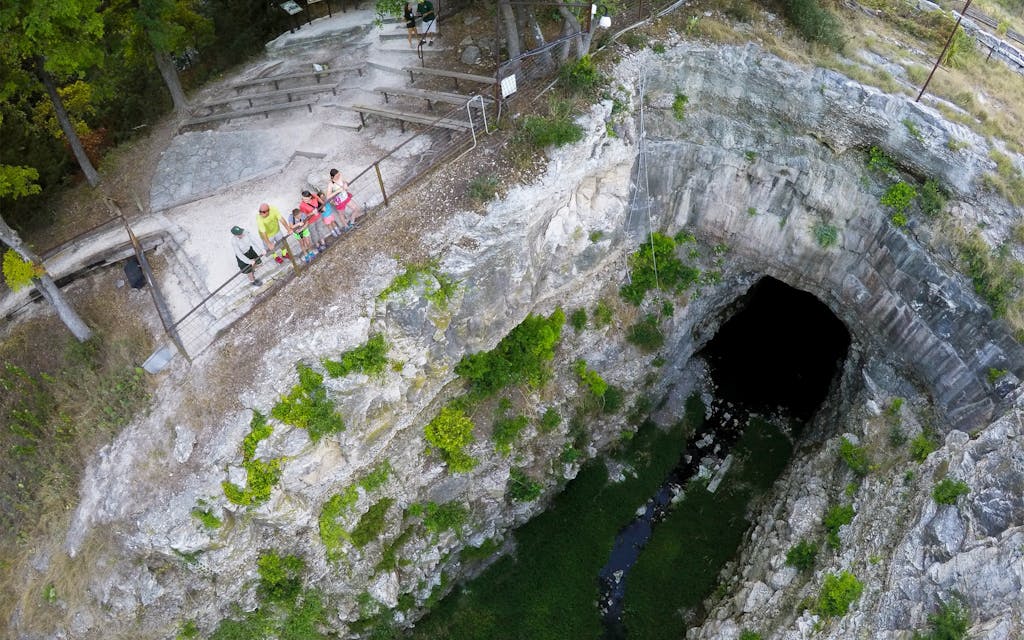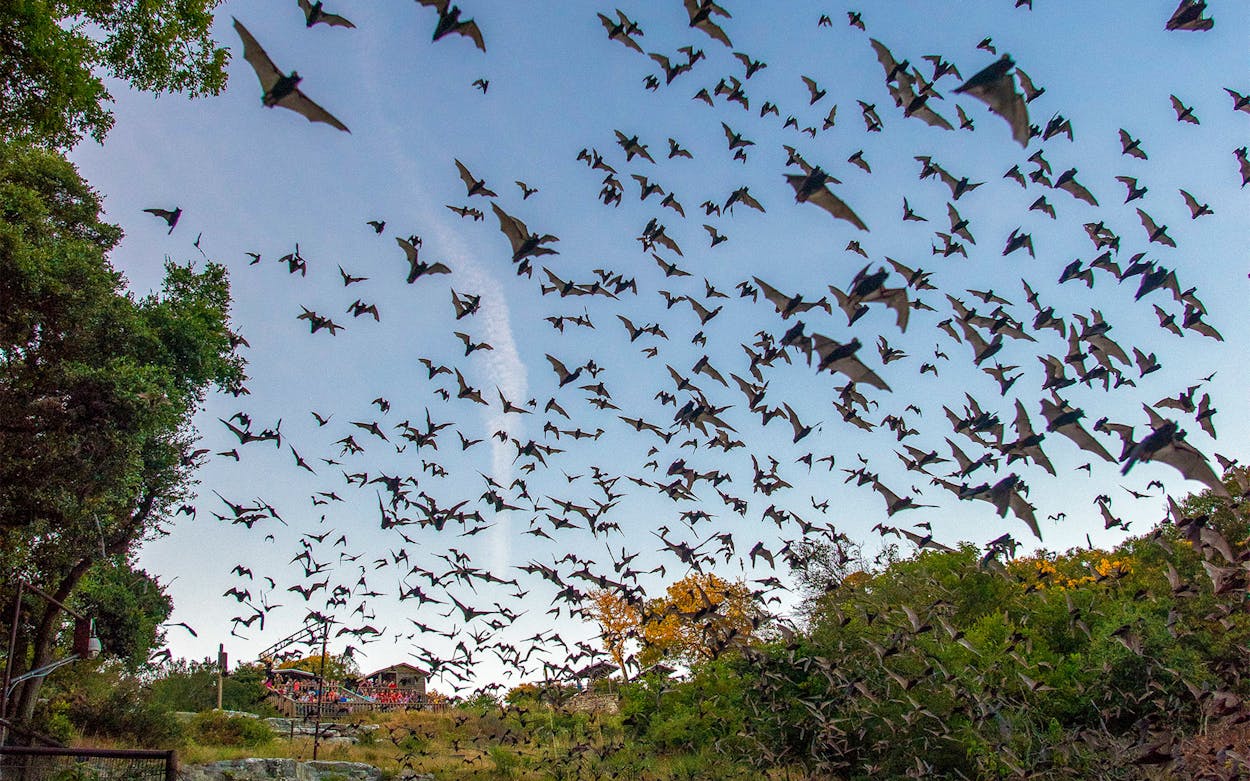Twenty minutes from downtown Fredericksburg—on a long, winding stretch of Old San Antonio Road that snakes past historic country schools, a vineyard with safari tours, and at least one ghost town—lies Old Tunnel State Park. At just sixteen acres, it’s the smallest state park in Texas. (The largest, Big Bend Ranch, in far West Texas, sprawls for more than 311,000 rugged acres.) But what Old Tunnel lacks in size, it makes up for in personality. After spending a pleasant summer evening there recently, I remembered an old theater adage: “There are no small parts (parks), only small actors.” This modest space teems with life, especially in the historic tunnel, where approximately two hundred Mexican free-tailed bats crowd into every square foot. During the peak months of mid- to late August and September, when mother bats return to raise their newborn pups, the bat population in the tunnel swells to upwards of three million. That’s double the number of the more famous colony under the Congress Avenue Bridge in Austin.
It was these flying mammalian anomalies that drew my family westward on a Sunday in July. Old Tunnel doesn’t seem to be a well-known attraction in this area, which is recognized for its wine scene and the showier Enchanted Rock State Natural Area. As we chatted with our hotel concierge about restaurants, I mentioned we were in town to see the bats. She looked aghast and exclaimed, “I don’t know what you mean!” I assured her it was a ways down the road at a state park.
Bats still have a PR problem—though not nearly to the extent they once did—with an undeserved reputation as bloodsucking terrors. In fact, only 3 of the planet’s 1,300 bat species are vampires, and despite what horror movies might have you believe, attacks on humans are vanishingly rare. Instead, bats do us a favor by consuming vast quantities of mosquitos (which the Centers for Disease Control and Prevention calls “the world’s deadliest animal”) and other pests, saving up to $1 billion a year in crop damage and pesticide costs. They also play a crucial role in pollinating plants and spreading seeds. Park superintendent Nyta Brown, Old Tunnel’s sole full-time staff member, delights in dispelling bat myths. Some of her favorite moments on the job are “when I have people come up to me after hearing my program and seeing the bats, and they tell me that I’ve changed their minds about bats.”

Old Tunnel’s low profile might also be due in part to its limited offerings. There’s no camping here, and the only thing to do other than watching the bats is to stroll the single half-mile hiking trail, where more than one hundred species of birds can be seen throughout the year. Reservations are required to stay at the park after 5 p.m.; you can buy yours online or by calling Texas Parks and Wildlife’s customer service center. General admission tickets to view the bats in the “upper area” are available every night of the week to all ages for $2 per person. For a spot closer to the emergence, in the “lower area” on Thursday through Sunday evenings, general admission tickets cost $5 per person for ages four and up. Front-row seats at a bargain? Reason number 1,416 why I love Texas state parks.
A handy, slightly cheeky flowchart posted at the park entrance guides unprepared visitors, letting them know these migratory bats are only in town between May and October (and noting that the rest of the year, “there’s nobody home!”). The sign is also updated with the time stamp of the latest bat emergence. Of course, wild animals do not always stick to a precise timetable, and adequate warning is given to that effect, alerting visitors to the possibility that the bats could emerge after dark (making visibility impossible) or fail to emerge at all, depending on weather and time. Park staff update Facebook and X pages with the most recent emergence time so visitors can arrive approximately an hour earlier for an educational program led by a volunteer, when available.
The park operates with a small but passionate crew of volunteers who sometimes drive long distances twice a month during bat season. We pulled up to the tidy entrance, which was manned by a smiling volunteer excited to engage us. As we walked up to the deck, she jokingly introduced us to a couple of retired volunteers: “. . . And here’s two old bats.” Despite the oppressive heat and a collective almost five decades (20 and 25 years, respectively) of volunteer service between them, these two women were spending yet another evening at Old Tunnel. I don’t blame them. We soaked in panoramic views of the uncluttered Hill Country vista while listening to an evening chorus of katydids, painted buntings, and white-eyed vireos. Not to mention the company, whose friendly banter made me feel as if I was on The Andy Griffith Show. I chatted with one of the volunteers about my only previous bat-viewing experience, at Nyamunini Island, in Rwanda, and she shared stories about her time at Old Tunnel—including memories of hopping the fence to see the tunnel with her father when she was five. Then my family and I headed down to explore the half-mile trail.
Visitors are welcome to explore the compact trail year-round during the day, but it closes when the bats emerge at dusk (so come early if you want to walk it before the evening viewing). There is a proliferation of signage, sharing everything from historical information to wildlife facts to warnings to “not sit or stand at fence during bat emergence.” That reminder wasn’t necessary for us, since the air was ripe with the pungent smell of what many mistake as bat poop but a sign clarifies as “a byproduct from the dermestid beetles breaking down the bat guano by eating the bacteria found there.” If you can tolerate the smell, which is strongest at the bridge near the tunnel, you can peer toward the man-made cavern to see the shadow of bats rapidly flying around inside. Old Tunnel provides the thrill of watching the food chain in real time. Hungry red-tailed hawks circled overhead, and a volunteer regaled me with a story of seeing a snake take its prey of a bat one evening. When we explored the trail again in the morning, we happened upon a wake of black vultures finishing their meal. As they ate, the birds emitted throaty rasps that reminded me of an old, disgruntled dog in the morning.
While my eldest daughter happily absorbed nature with my DSLR camera, capturing the armadillo rustling under the bridge and a giant cobweb thread stretched between the branches of a black walnut, my youngest complained to her sister, “Can you believe I like getting shots better than hiking?” I felt comforted when I later heard another mom remark to her child, “You’re complaining. Like you’ve never been outside before.” You win some, you lose some. For the not-disgruntled persons visiting the park, I found the trail, rife with beautiful views and fascinating nature discoveries, utterly delightful. A 0.24-mile loop at the tail end even provided a brief, rocky limestone terrain on which to walk up and down. It offered respite from the smell of bat guano; here, the air was perfumed with the pleasant scent of ashe juniper.
More than a century ago, this landscape bustled with crowds gathered to celebrate the train’s arrival. “Big Hill,” as the tunnel of the Fredericksburg and Northern Railway was known, was excavated from the solid limestone in five months in 1913. Most of it was dug out by hand, a product of the grueling labor of a hundred workers. The 920-foot tunnel serviced steam-powered locomotives traveling between Fredericksburg and San Antonio until 1942, when the never-quite-profitable line was officially dismantled and sold for scraps by the War Department. Within a few years Mexican free-tailed bats took residence in the abandoned tunnel’s near-perfect conditions. The colony is pseudo-maternal, meaning that pups are raised but not born here. Since the tunnel’s temperatures (even in a sweltering Texas summer) remain too cool for the mothers to give birth inside, they leave the colony briefly for warmer spots in caves or under bridges nearby. Within a couple weeks of giving birth, the mothers return to Old Tunnel with their little native-born Texans in tow, and the numbers reach their apex in late summer before the colony migrates back to Mexico in the fall.
As our state bakes in a heat dome, I find comfort in knowing the manufactured condition of this park is what created an environment where nature now thrives. There was time for questions during the educational program, and my oldest raised her hand to ask, “Are there any other bat species in this area?” The volunteer explained that approximately three thousand cave myotis bats also take up residence here, though they are a hibernating species. Just as it seemed the questions and conversation had petered out, at 8:49 p.m., three minutes after the previous emergence, a couple of bats darted into the sky. Almost immediately a rush of bats flooded out from the tunnel, with such intense velocity that their movement created an appreciable breeze on the uncomfortably still night. Somehow the frenetic flight of bats swirling upward in a counterclockwise motion provided a meditative viewing as I watched them continue to billow out and up and away. As darkness descended, they appeared more like an apparition, ghostly shadows fading into the darkness as a few fireflies brought a moment of light.
- More About:
- Parks & Recs
- Critters
- Fredericksburg






